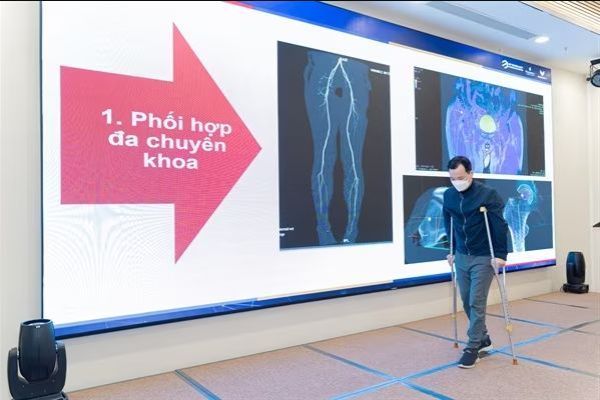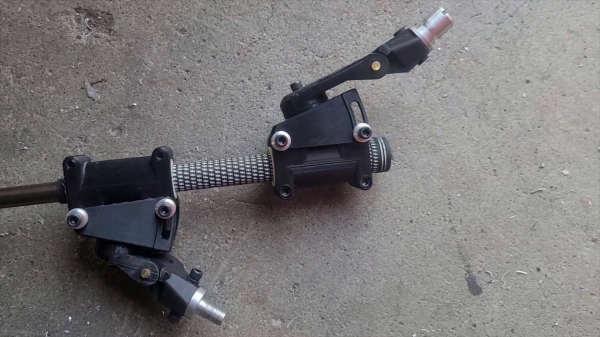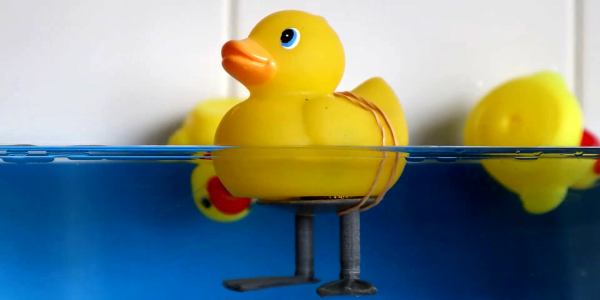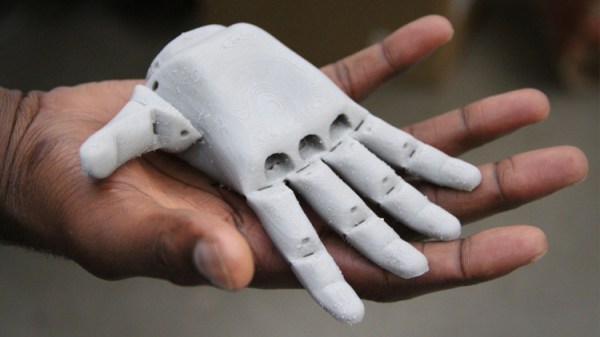On December 22nd of 2023, a Vietnamese patient underwent hours-long surgery in order to remove part of his pelvis and femur, as per the usual treatment for bone cancer. What was special here was that the bone was replaced with 3D-printed replicas, to restore the shape and function of the parts that were removed. A long time before this surgery, [Mr. Le Dinh Thuan] was diagnosed with lung cancer, for which he received surgery. Yet not long after this surgery it was discovered due to sudden hip pain that the cancer had spread to one hip joint, which is quite uncommon, but requires that the affected bone is removed. This replacement with a prosthetic was a first for cancer treatments in Vietnam. Continue reading “3D Printed Pelvis And Femur Implants For Bone Cancer Treatment”
3d printed prosthetic23 Articles
Missing Finger Gets A Simple Yet Fancy Replacement
The possibility of a table saw accident is low, but never zero — and [Nerdforge] has lost a finger to this ever-useful but dangerous contraption. For a right-handed person, losing the left hand pinky might not sound like much, but the incident involved some nerve damage as well, making inaccessible a range of everyday motions we take for granted. For instance, holding a smartphone or a pile of small objects without dropping them. As a hacker, [Nerdforge] decided to investigate just how much she could do about it.
On Thingiverse, she’s hit a jackpot: a parametric prosthetic finger project by [Nicholas Brookins], and in no time, printed the first version in resin. The mechanics of the project are impressive in their simplicity — when you close your hand, the finger closes too. Meant to be as simple as possible, this project only requires a wrist mount and some fishing line. From there, what could she improve upon? Aside from some test fits, the new finger could use a better mounting system, it could stand looking better, and of course, it could use some lights.
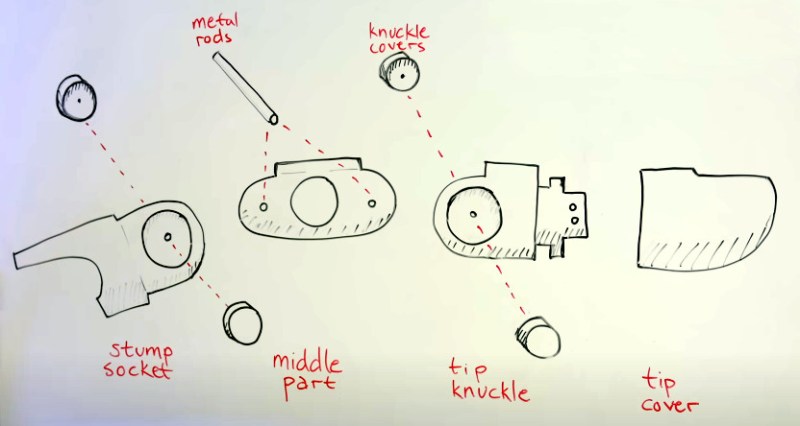 For a start, [Nerdforge] redesigned the mount so that the finger would instead fasten onto a newly-fingerless glove, with a few plastic parts attached into that. Those plastic parts turned out to be a perfect spot for a CR2032 battery holder and a microswitch, wired up to a piece of LED filament inserted into the tip of the finger. As for the looks, some metal-finish paint was found to work wonders – moving the glove’s exterior from the “printed project” territory into the “futuristic movie prop” area.
For a start, [Nerdforge] redesigned the mount so that the finger would instead fasten onto a newly-fingerless glove, with a few plastic parts attached into that. Those plastic parts turned out to be a perfect spot for a CR2032 battery holder and a microswitch, wired up to a piece of LED filament inserted into the tip of the finger. As for the looks, some metal-finish paint was found to work wonders – moving the glove’s exterior from the “printed project” territory into the “futuristic movie prop” area.
The finger turned out to be a resounding success, restoring the ability to hold small objects in ways that the accident made cumbersome. It doesn’t provide much in terms of mechanical strength, but it wasn’t meant to do that. Now, [Nerdforge] has hacked back some of her hand’s features, and we have yet another success story for all the finger-deficient hackers among us. Hacker-built prosthetics have been a staple of Hackaday, with the OpenBionics project in particular being a highlight of 2015 Hackaday Prize — an endearing demonstration of hackers’ resilience.
Continue reading “Missing Finger Gets A Simple Yet Fancy Replacement”
Designing A Simpler Prosthetic Finger
Prosthetic limb design is an area where desktop manufacturing has made huge strides, but there’s always room for improvement. For example, take a look at [Ian Davis] and his attempts to design a simpler prosthetic finger.
[Davis] favors his aluminum partial hand prosthetic for its strength, but because it was scratch built for his particular situation, it isn’t easy to recreate for someone else. To this end, he has started working on a simpler design that might be applicable in the future for people who want to build their own prosthetics. With less than ten major components per finger including the replaceable TPU fingerpads, this is a major step toward that end.
According to [Davis], one of the more exciting parts of the build is that while this hand has a more limited feature set, he was able to get it closer to the size of his natural hand. Because of the durability problems he’s experienced for day-to-day use of plastic prosthetics, he is having the next iteration 3D printed in stainless steel for further testing.
If you want to see some more interesting prosthetic designs, checkout the Kid Who Designed His Own Prosthetic Arm or this Skull Lamp Prosthetic Eye.
3D Printing A Prosthetic-Compatible Golf Club
Relearning an old sport, or starting a new one, can be challenging for amputees. Besides the obvious physical aspects, custom prosthetics or adaptors might need to be made and fitted, which can be very expensive. With the power of 3D printing and some machining, [Ian Davis] was able to build a custom prosthetic golf club to get a quadruple amputee back on the greens.
The recipient of this prosthetic lost both hands above the wrists, so [Ian] had to come up with a mechanism that could hold the club and mimic wrist motion throughout the swing. He was able to achieve this motion with a simple four-plate hinge for each arm. For optimal ergonomics, [Ian] also added two-axis adjustability, with only a single bolt needing to be loosened per axis. A standard golf club can be used and is clamped in the printed holders.
Machined prosthetic sockets were used to allow quick connection to the user’s existing prosthetic forearms. Theoretically, this should also allow him to switch clubs without excessive hassle. [Ian], an amputee himself, has used his engineering skills to build a series of prosthetic hands and even a custom controller mod to get back to gaming with fewer flesh fingers.
Continue reading “3D Printing A Prosthetic-Compatible Golf Club”
3D Printing Delivers “Glass” Eyes In Record Time
Obviously, losing an eye would be bad for your vision. But if you think about it, it is also a detriment to your appearance. You might not need a prosthetic eye, and you can certainly rock an eye patch, but a lot of people with this problem get an artificial or “glass” eye. These glass eyes are hand-painted disks that fit into the eye socket. However, a British man now has a new kind of eye prosthesis that is 3D printed, a technology that can potentially cut waiting time for patients in half.
The existing process is lengthy because it requires taking a mold of the eye socket and manually matching the remaining eye with the new artificial eye. With the 3D printed technology, scans of the eye socket and the other eye make this process much simpler.
Moorfields Eye Hospital, the source of the eye, says that a conventional eye takes about six weeks, but the new ones take no more than three weeks. The patient only needs to spend about a half-hour doing the scans before the wait starts. We presume it can be made for less cost, as well.
Medicine is embracing 3D printing and we’ve seen a 3D ear. We are waiting for our personal exoskeleton. Some of the medical 3D printing we’ve seen is for the birds.
Plastic Prosthetics For Rubber Duckies
Will someone please think of the rubber duckies?!
For decades they’ve been reduced to a laughing stock: a caricature of waterfowl. Left without a leg to stand on, their only option is to float around in the tub. And they don’t even do that well, lacking the feet that Mother Nature gave them, they capsize when confronted with the slightest ripple. But no more!
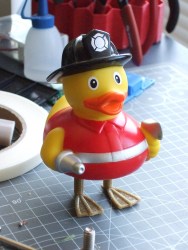
Due to the wonders of 3D printing, and painstaking design work by [Jan] from the Rubber Ducky Research Center, now you can print your own rubber ducky feet. We have the technology! Your ducks are no longer constrained to a life in the tub, but can roam free as nature intended. The video (embedded below) will certainly tug at your heartstrings.
OK, it’s a quick print and it made my son laugh.
The base and legs probably don’t fit your duck as-is, but it’s a simple matter to scale them up or down while slicing. (Picture me with calipers on the underside of a rubber ducky.) The legs were a tight press-fit into the body, so you might consider slimming them down a tiny bit when doing the scaling, but this probably depends on your printer tolerances.
It looks snazzy in gold-fleck PETG, and would probably work equally well for some more elaborate rubber duckies as well.
Nerds Unite: Prosthetics Inspired By Comics And Beyond!
Open Bionics is a company creating prosthetics inspired by heroines, heroes and the fictional worlds they live in. The designs emblazoned on their first set of bionic hands include ones drawn from Queen Elsa from Disney’s Frozen, and Marvel’s Iron Man. The best thing about what they are doing is they offer you, dear reader, a chance to lend your own super powers of design and engineering. Open Bionics offers up 3D print files for several hand designs, hardware schematics and design files for their controller boards, firmware, and software to control the robotic hands with. Other than their website, you can also find all of the files and more on their GitHub account. If you’d like to devote a good amount of time and become a developer, they have a form to contact them through. To help with sourcing parts for your own build, they sell cables for tendons, muscle sensors, and fingertip grips in their online store.
 We first came to learn about this company through a tipster [Dj Biohazard] who pointed to a post about their partnership with an 11-year-old Tilly, who is pictured on the left. Her bionic hand is an Open Bionics prototype whose design is based on the video game, Deus Ex. The best way products like these are improved are through the open source community and people like her.
We first came to learn about this company through a tipster [Dj Biohazard] who pointed to a post about their partnership with an 11-year-old Tilly, who is pictured on the left. Her bionic hand is an Open Bionics prototype whose design is based on the video game, Deus Ex. The best way products like these are improved are through the open source community and people like her.
Specific improvements Open Bionics state on their website are:
- The customised bionic arms are manufactured in under 24 hours and the revolutionary socket adjusts as the child grows.
- The bionic arms are light and small enough for those as young as eight.
- The bionic arms use myoelectric skin sensors to detect the user’s muscle movements, which can be used to control the hand and open and close the fingers.
Read more about Tilly’s story and her partnership with Open Bionic’s on Womanthology. Tilly seems to have a dream of her own to “make prosthetics a high fashion piece – something that amputees can be proud to wear.”
We at Hackaday have written about several open source prosthetic developments such as a five-day event S.T.E.A.M. Fabrikarium program taking place at Maker’s Asylum in Mumbai and the work of [Nicholas Huchet]. What superhuman inspired designs would you create?

